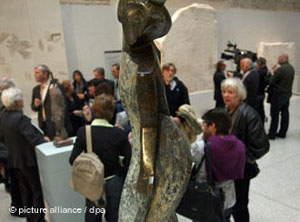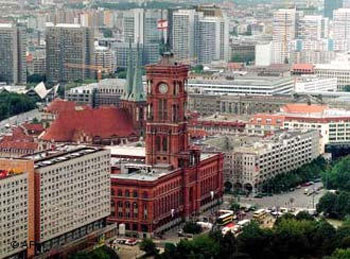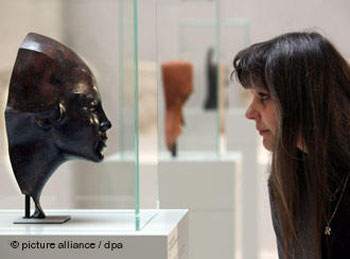
 Sculpture News at SculptSite.com
Sculpture News at SculptSite.com
Nazi-Confiscated Sculpture |
|
 |
Dubbed "degenerate art" the Nazis, a collection of 11 sculptures by various German artists went missing during World War II. They are now on display at the Neues Museum in Berlin. |
| DW-WORLD.DE Author: Juergen Koenig (ew) Editor: Kate Bowen Collection of Nazi-confiscated art uncovered in BerlinA collection of classical modernist sculptures has been uncovered in central Berlin, found during excavation work for an underground metro link. The 11 pieces had been missing for decades after being labeled by the Nazis as "degenerate art." Eight of the sculptures, some of which are damaged, have been identified as the works of German artists Otto Baum, Otto Freundlich, Karl Knappe, Marg Moll, Emy Roeder, Edwin Scharff, Gustav Heinrich Wolff and Naum Slutzky. The other three have not yet been identified, according to Hermann Parzinger, head of the Berlin-based Prussian Cultural Heritage Foundation. A lucky strike The sculptures were found underground next to Berlin's town hall; what is now a large open space used to be a city center, full of houses, shops and offices. According to archeologist and director of Berlin's museum of early history, Matthias Wemhoff, the excavators suddenly came across an object that fell down and produced a rather metallic sound. It was "totally covered in grout" but later identified as the sculpture of actress Anni Mewes by artist Edwin Scharff "You think you're excavating a town hall from the 13th century, which is already significant enough in itself," said Hermann Parzinger from the Prussian Cultural Heritage Foundation, "[...] and then you find 'degenerate' art." The Nazis categorized as "degenerate" modern art that did not glorify their ideals. The affected artists, many of them Jewish, were subject to sanctions. Some works were destroyed, while others were hidden from the authorities, only to be rediscovered discovered after the war - in this case, many years later. Berlin mayor Klaus Wowereit said he saw the find as "a small miracle" and a successfully foiled Nazi attempt to "ban this classical modernity from German history." There are indications that the artworks had been stored in what used to be house number 50 on Koenigstrasse, now known as Rathausstrasse. Number 50 housed the office of tax advisor Erhard Oewerdieck, a man who at one point employed Jewish bookkeeper Martin Lange and provided him with a hiding place before organizing his escape to the US. "We have no proof that the sculptures were in Erhard Oewerdieck's possession or stored in the apartment - we only have clues," said Wemhoff. "We now have to find out who else had this apartment." Survivors of neglect The identified sculptures, created in the 1920s and early 1930s, include standing figures by Otto Baum, Gustav Heinrich and Karl Knappe, a head by Otto Freundlich, a dancing figure by Marg Moll, a pregnant woman by Emy Roeder, the bust of Anni Mewes by Edwin Scharff and a bust of a woman by Naum Slutzky. Although they have been relatively well preserved, according to Wemhoff, they still show signs of the neglect they suffered. "If you look at this sculpture now, it's very different from the way it was in the 30s," said Wemhoff of the dancer figure by Marg Moll. "It's no longer shiny brass. It's a sculpture that has experienced a certain transformation." He also took the figure created by Karl Knappe as an example, pointing out the eroded structures of its face, which is "marked by fire." "That's when you see what fate these sculptures have suffered," added Wemhoff. Confiscated by the Nazis, the sculptures were part of a "degenerate art" exhibition in 1937 and then delivered to the Third Reich's ministry of propaganda. During World War II they disappeared without a trace and were subsequently classified as "lost" by German museums. Decisions about the future The Prussian Cultural Heritage Foundation is working together with the museums that used to display the sculptures to work out the issue of ownership. However, according to Klaus Wowereit, the most important thing is that the sculptures have been found. "That's the special thing, and that's why for me the question of where or who they belong to, or where they will stand later, is not the priority right now," said Wowereit. "Being able to present them is an unusually fortunate situation." As of November 9, the rediscovered works are on display in Berlin's Neues Museum. |
 More on this intriguing story of eleven sculptyres unearthed in Berlin. We though this article to have a bit more detail. We are striving to get more images. |
 The works were found near Berlin's town hall, in the heart of the city |
 The bust of Anni Mewes was found covered in grout |
More Sculpture News ....
Submit your SCULPTURE NEWS.
It's easy, just send us an e-mail
(click on Submit News in the left menu) with your pertinent information along with images, we'll take care of the rest. Sculpture makes our world a much better place in so many ways!
SculptSite.com, along with Sculptors and their creative genius all helping to bring the beauty and message of Sculpture to a hurried world.

